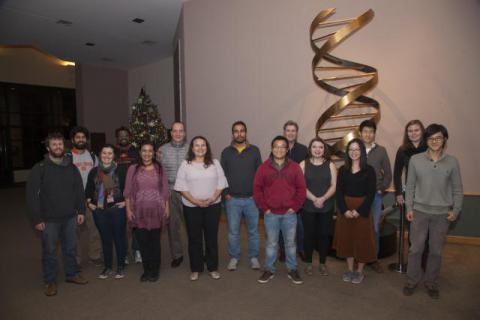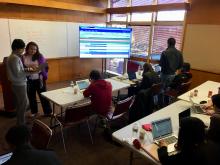The Gramene and MaizeCode Projects launched the first Maize Annotation Jamboree
The first genomic annotation jamboree for B73 Zea mays (maize) RefGenV4 Zm gene models was held on December 3-5, 2017 at Cold Spring Harbor Laboratory (CSHL). Sponsored by the NSF-funded Gramene (IOS-1127112) and MaizeCode (IOS-1445025) projects, the jamboree aimed to promote the involvement of the plant research community in the improvement of the V4 gene models. It also served as a proof-of-concept for similar future efforts to improve genomic annotations in maize, sorghum, grape, and other important crops.
Over 65 researchers in one or more of the following categories were invited to nominate a graduate student or post-doctorate:
- Willing to contribute to maize gene annotation efforts via a community survey (MaizeCode Project).
- Collaborated with MaizeGDB in curation activities.
- Reported potential annotation errors in maize models via the Gramene Database feedback platform.
- Representatives of the sorghum research community looking to provide feedback on gene annotation and resource development.
Including applicants from underrepresented minorities, a total of 10 graduate students and 1 post-doc were selected to participate in this event: Rachel Wasikowski from the University of Toledo, a primarily undergraduate-serving institution (PUI) in Ohio; Hao Wu and Kokulapalan Wimalanathan, both from Iowa State University; Michelle Stitzer from the Unviersity of California, Davis; Pengfei Qiao from Cornell University; Junpeng Zhan from the University of Arizona; Rajdeep Singh Khangura from Purdue University; Sirjan Sapkota and Zach Brenton, both from Clemson University; Michael Okoro from New York University; and Fei-Man Hsu from the University of Tokyo.
Thanks to the enthusiastic support of CSHL Meetings & Course Program, jamboree participants were able to participate at the Plant Genomes and Biotechnology: From Genes to Networks (PGB) meeting, held from November 29th through December 2nd at CSHL, and the Gramene and CyVerse-sponsored bioinformatics workshop on plant genomics tools that was held prior to the PGB meeting.
During the PGB meeting, jamboree participants presented 2 high-impact talks: Michelle Stitzer on “Ecological determinants of transposable element survival in Zea mays” and Fei-Man Tsiu on "Optimized reduced representation bisulfite sequencing reveals tissue-specific mCHH islands in maize”, and 3 posters: Hao Wu on “Gene regulatory network analysis of key regulators associated with maize endosperm development”, Junpeng Zhan (in collaboration with Hao Wu) on “Analysis of the Opaque-2 regulatory network uncovers the timing and complexity of storage-program gene regulation during maize endosperm development”, and Pengfei Qiao on “Transcriptomic analyses of leaf cuticular-epidermal development in maize”.
On the first day of the the annotation jamboree, Monica Munoz-Torres (currently at Phoenix Bioinformatics, and former Project Manager of the Apollo project), introduced participants to the web-based Apollo genomic annotation editor. Event participants were assigned to work on one of five maize gene families (Pin, GH3, ABC, TCP and ORC) carefully selected for including one or more gene transcripts targeted for potential improvement given an Annotation Edit Distance (AED; Campbell et al, 2014) parameter equal or less than 0.5, and a Quality Index 2 (QI2, the fraction of splice sites confirmed by an EST alignment; Cantarel et al, 2008) parameter between 0.33 and 0.75. The objective being to have a minimum of 2 participants working independently on the same set of models to compare methodology, results, conclusions, timing, etc. Participants presented their findigs to the group and group discussions were held by the end of this first day. On day 2, participants focused on annotating genes of their own interest and summarizing their overall findings, as well as providing feedback on the editing tool, the Gramene resource, and their overall experience.
Jamboree participants will continue to annotate their genes of interest and the group will meet periodically to discuss progress and write an official report that we plan on submitting to an educational journal. In addition, Michelle Steitzer will present a summary of the results of this exercise at the Plant and Animal Genome (PAG) conference in San Diego, CA on January 15th, 2018.

First Maize Annotation Jamboree group photo

Annotating maize gene models with Apollo
- marcela.karey's blog
- Log in to post comments
